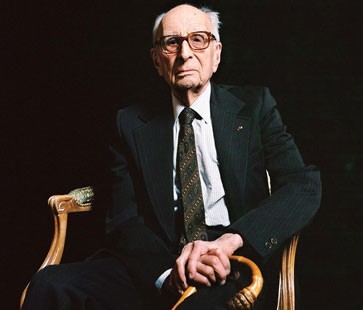Obituary
Claude Lévi-Strauss
Claude Lévi-Strauss, anthropologist, died on October 30th, aged 100.
Before Claude Lévi-Strauss revolutionised the discipline, anthropology in France, and generally elsewhere, was a matter of ill-attended lectures in small, cold halls, and the collection of feathers and fish-hooks as evidence of the quaint divergences of the “primitive” tribes of mankind. He made it as fashionable as philosophy and poetry, both of which he wove through his ethnographical studies as perhaps only French intellectuals can. The proper study of mankind was indeed man: not in his politicking, warring or banking, but naked, painting his body, hunting bears, snaring birds. Here lay the universal truths about how the human mind worked and what man was.

在克洛德·列維-斯特勞斯變革這門學科之前,無論在法國,還是世界其它地方,人類學普遍是下面的情形:又小又冷的講堂,冷冷清清的課堂,各色的羽毛和魚鉤(作為人類“原始”族群文化多樣性的證物)。列維-斯特勞斯讓人類學變成了和哲學、詩歌一樣時髦的東西,并把這兩種元素融入進自己的民族學著作中,這恐怕只有法國的知識分子才辦得到。研究人類就應該純粹去研究人:不是披著政客、士兵或銀行家外衣的那類人,而是赤身裸體、膚著油彩、獵熊捕鳥的這類人。這里存在著關于人類思考模式及人之本性的普遍真理。
Obedient to Rousseau, who always “set him aflame”, Mr Lévi-Strauss observed men from afar. He never got too near or stayed too long in his rare stints of field-work, mostly in Brazil in the 1930s; he grasped only a few words of the languages, and avoided the “hateful” distractions of individual characters. In the bitter phrase of Jean-Paul Sartre, with whom he sparred for years, he preferred to view men like ants. He focused not on their differences but on the deep-lying patterns and systems in everything they did, until he could proclaim that all tribal myths were reducible to one formula, and that all human thought, “savage” or not, was built up from binary opposites such as hot and cold, night and day, raw and cooked, good and bad. Round these concepts whole societies, as well as stories, were organised.
Mr Lévi-Strauss, throwing down the gauntlet in “La Pensée Sauvage” in 1962, saw nothing primitive about the tribes he studied. Totemism, for example, was a system as complex as the Linnaean classification. In tribal myths, apparently diverse and arbitrary elements—eruptions by lizards and woodpeckers, the significance of black arrows or the artemisia plant—were suddenly revealed to have a universal unity at their heart, a quest for objective knowledge and origins as acute as any in the West. The minds behind them were not savage, just “untamed”. The salient difference was that his tribesmen stayed within their limits, simply putting the materials they had together in new ways, like handymen or bricoleurs. “Civilised” man, on the other hand, tried to defy his constraints and change the world with new inventions, like an engineer.
The world needed both these types, said Mr Lévi-Strauss. And he embodied both. He too hopped from subject to subject like a bricoleur, discarding philosophy for its arid moralising, giving up law out of sheer boredom, vaunting socialism until it tired him, turning to anthropology as if he was still a fascinated boy in a curio shop. He abandoned theories like scorched earth in the forest. But the far-sighted engineer in him set up a “laboratory” at the Collège de France, where he held the brand-new chair of social anthropology from 1959 to 1982, and produced the four huge volumes of “Mythologiques” (1964-71), in which he tracked 813 myths the length of the American continent. He happily called himself both “neolithic” and a man of science.
The underlying order
Generations of students considered him the father of structuralism—the theory of underlying order in everything. This annoyed him. He invoked the word in the 1950s mostly in homage to linguists like Roman Jakobson, who had posited binary opposites (voiced and voiceless elements) as the building blocks of language. Thereafter structuralism had become a “vogue”, he thought, “besmirched” by being wrongly applied, and weirdly linking him with thinkers—Jacques Lacan, Michel Foucault—with whom he had nothing in common.
But there was really no avoiding structure in his life. He loved Rameau’s music, Poussin’s paintings. His own career appeared to contain a fair element of chance: the second world war, with exile in New York, that led him to Jakobson, or his meetings with Max Ernst and André Breton, who taught him to look at objects with a surrealist’s eye. And yet possibly all this too, as he wrote in “Tristes Tropiques” in 1955, exemplified how, over time, “events without any apparent connection, and originating from incongruous periods and places…suddenly crystallise into a sort of edifice conceived by an architect…”
Ever diffident and retiring, he wished to be remembered only for his “moment in anthropological thought”: an effort at systematising cultures as profound, he hoped, as what Marx had done for ideologies, or Freud for dreams. Proselytising was left to his difficult, often beautiful, books and the pages of his journal L’Homme. The existentialists, and all who thought that man should be studied as an individual rather than en bloc, noisily attacked him. He dismissed their “shop-girl metaphysics”.
Before his immense age turned him into a national treasure for thinkers of all stripes and none, greens claimed him, and he was happy to be claimed. The consumer filth and monoculture of the “civilised” world had depressed him ever since the writing of “Tristes Tropiques”. As he faded, he mourned the vanishing of the tribes. “Primitive” man was not nobler or purer than he was, but they were, in the deepest sense, connected: for universal laws linked his thinking, in all its book-lined complexity, to that of the Indian clad only in tree-bark, trailing a deer along a forest path.











